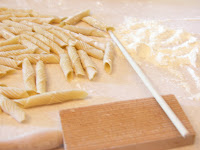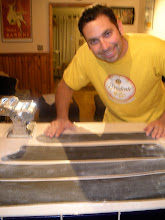The first, and most common (though by no means common), was his Ravioli di Due Zucche: roasted delicata (from Goranson Farm, also at the BWFM) and kuri squashes with mascarpone cheese. This was the first, and only, ravioli we offered at our first farmers' market and it went like hot cakes! We sampled it out with a little EVOO, s&p, and some freshly grated nutmeg. Even at room temperature they were to die for!
At the second farmers' market we introduced our second ravioli, a dried Maine cranberry- and goat cheese-filled delicacy: Ravioli con Mirtilli Rossi e Formaggio di Capra. We got our cranberries from Sparrow Farm, who is at the BWFM, too. This is a little sweeter than your typical ravioli and will be an awesome addition to our Thanksgiving-Sunday supper tomorrow! (My dad, Ancora Pasta's own walking advertisement, is overjoyed that he was finally able to lay his hands on some of these ravioli as I previously sold the packages he'd reserved right out from under his nose!)
Mr. Ancora Pasta's favorite ravioli, the one he waxes most poetic about, is the Ravioli ai Funghi - Mushroom Ravioli. These are made with oyster mushrooms and locally foraged black trumpet mushrooms from Oyster Creek Mushroom Company (from my hometown of Damariscotta!). Mr. AP paired the mushrooms with a gorgonzola dolce, a softer, sweeter version of the strongly flavored blue cheese we commonly see here in the U.S. These ravioli are earthy and delicate and absolutely amazing.
The ravioli I provided for m
 y Thanksgiving-day meal with my family was the Ravioli di Due Stagione (Two-Season Ravioli), named for its use of seasonal ingredients: maple syrup (spring) and acorn squash (fall), both from Goranson Farm. The maple syrup was a congratulations gift from my dad upon our highly successful first farmers' market, and the acorn squash was given to us in a trade between farmers' market vendors. (This act of trading among vendors is a nice little tradition at the farmers' market and certainly helps our goal of using as many products from the farmers' market as possible.)
y Thanksgiving-day meal with my family was the Ravioli di Due Stagione (Two-Season Ravioli), named for its use of seasonal ingredients: maple syrup (spring) and acorn squash (fall), both from Goranson Farm. The maple syrup was a congratulations gift from my dad upon our highly successful first farmers' market, and the acorn squash was given to us in a trade between farmers' market vendors. (This act of trading among vendors is a nice little tradition at the farmers' market and certainly helps our goal of using as many products from the farmers' market as possible.)And, last, but not least, the Ravioli alle Castagne.
 These chestnut ravioli were served today at our more "Italian" Thanksgiving brunch with Mr. Ancora Pasta's family. Chestnuts are one of those special treats common in his family's winter gatherings and there was no way we could overlook the perfect combination of nutty flavor and soft bite these nuts provided. Today we served them with a salsa alle noci, a light walnut and Tuscan cheese sauce. They were gobbled (ha!) up in minutes!
These chestnut ravioli were served today at our more "Italian" Thanksgiving brunch with Mr. Ancora Pasta's family. Chestnuts are one of those special treats common in his family's winter gatherings and there was no way we could overlook the perfect combination of nutty flavor and soft bite these nuts provided. Today we served them with a salsa alle noci, a light walnut and Tuscan cheese sauce. They were gobbled (ha!) up in minutes!We anticipate many more types of ravioli and other stuffed pastas at upcoming farmers' markets. Christmas will feature new fillings such as a savory pear and pecorino cheese and a chocolate peppermint (dessert, anyone?). What would YOU like to see on our Christmas list?




